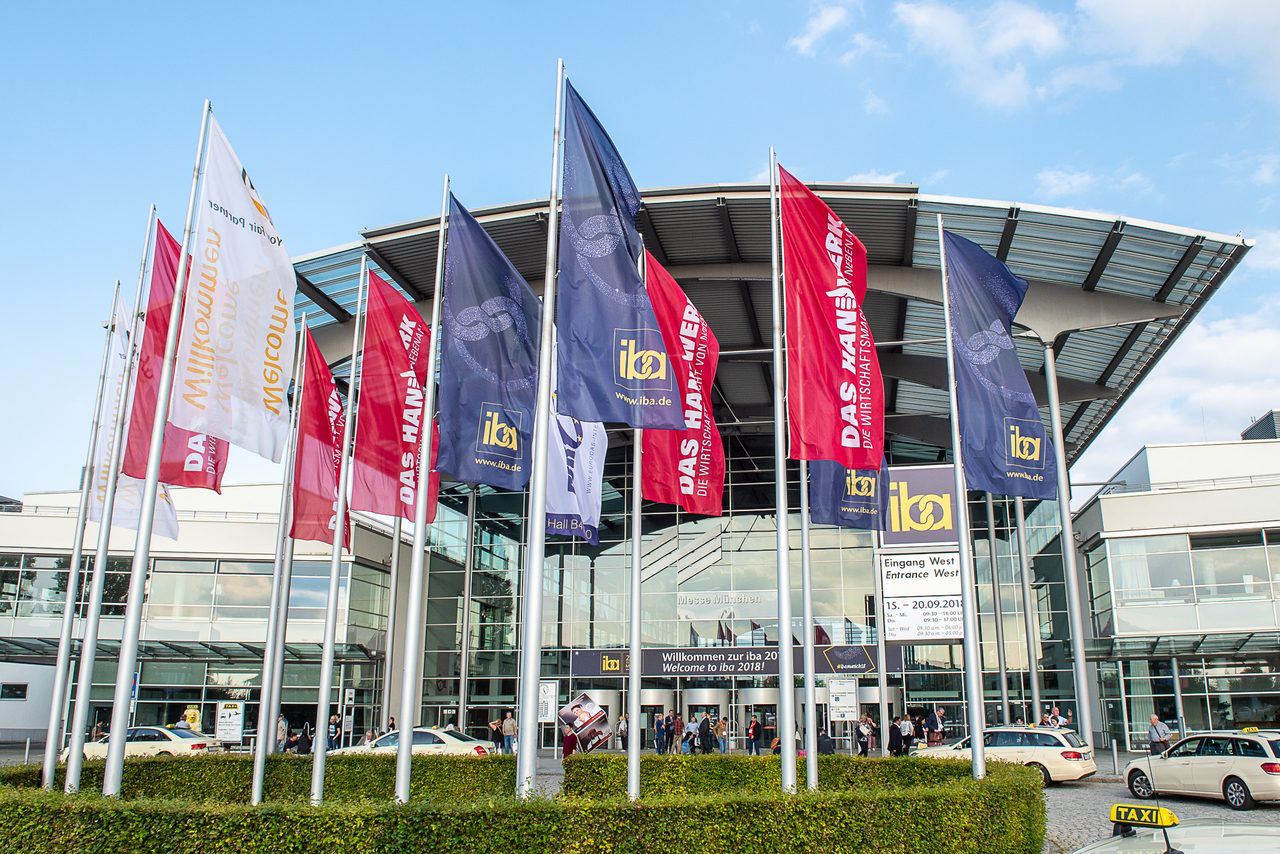Europe
report
The BOTTOM LINE
- Addressing the labor market
- Flexible and versatile solutions
- Preparing for future challenges
European bakery trends
Perspectives from Europe bring value to discussion of international baking industry trends.
Douglas J. Peckenpaugh, Group Editorial Director
Bread is a universal language. Nearly every culture has historical roots in forming judicious combinations of water and grains, seeds, pulses, starches, and other substrates, often functionally lightened with some sort of leavening, and perhaps a dash of salt for flavor. It’s the quintessential expression of science, art, and sustenance.
From this unity, we diversify into myriad delectable directions, as cultures and countries continually interact with their daily bread—at home, in retail bakery storefronts, at the local grocery store, or away from home at a restaurant or food truck. Europe, in particular—the epicenter of the global baking industry—offers a wealth of valuable market perspectives.
As in the U.S., the baking industry in Europe is growing. According to a March 2020 report, “European Bakery Market—Forecast (2020-2025)” from IndustryARC, European bakery market revenue was estimated at $226 billion in 2020, with a forecasted CAGR of more than 3.3 percent through 2025.
International perspectives
“In Europe, the level of consumption of bread and pastries in traditional bakeries remains the majority,” says Anne Lionnet, business developer, LifyWheat, Limagrain Ingredients, Weert, the Netherlands. “Bread is an eminently cultural product, so there are major differences in recipes, shapes, and tastes between French, German, and English bread. The breads found in traditional bakeries have a short shelf life, and are generally bread for the day in Europe.”
Image courtesy of DKosig via iStock / Getty Images Plus
Local bread types can differ quite a lot between different countries in Europe, says Wes Shadow, global market and portfolio manager, grain, food segment, PerkinElmer, American Fork, UT. “In general, Western Europe is coming from a higher degree of industrial baked bread than Eastern Europe.” Overall, the general trend is toward more “handicraft-type” breads, and more sustainable and healthy products, including those made with whole-grain meal and locally grown, environmentally friendly crops. “The trend toward locally made bread has been fortified by the pandemic situation,” he notes.
Europe has a pronounced focus on sustainability and organic food, notes Ronald Falkenberg, Master Baker and regional sales director, USA and Canada, DIOSNA North America, Atlanta. “The avoidance of additives is also a big issue, and almost a matter of course for consumers.” He notes demand for protein-rich, low-carbohydrate bread is also high in Europe, and that the trend toward more vegetarian and vegan baked goods is developing.
Lionnet also taps “the desire to consume locally” as a growing trend in Europe, often in connection with sustainable development, including a reduction of food miles necessary for transport to reduce environmental impact.
For European bread and pastry, the use of natural ingredients, sourdough, mother yeast, and ancient grains mixed together and processed slowly—long resting and proofing time—are the key factors to obtain high-quality bread and pastries, as required by most consumers nowadays, says Stefano Bruni, strategic marketing manager, bakery industry, FLX Hub, IMA spa, Bologna, Italy.
“This trend of high demand for artisan product is also visible in the packaging area, where most producers are willing to give customers a ‘return to origins’ feel,” says Bruni. “Most European bakers are thus willing to use paper-based flexible packs in order to give the final product a look as ‘artisan’ as possible, while giving the impression of a more ecofriendly packaging, which rely less on plastic.”
Most European customers are still guided by indulgence for cakes and muffins, says Bruni. “Therefore, healthy proposals are still not so common on market shelves, but they are picking up.” Today, one of the main tasks for bakers is to obtain a nice product using special flours, less sugar, and less fat, he notes.
The market is also quickly moving toward smaller, single-serve portions to reduce calorie intake, says Bruni. “This latter trend clashes with sustainability, because a 500-gram box containing lighter, single-serve products will be composed by more single-packed pieces, and therefore a higher quantity of plastic and packaging material in general.”
Nutritional trends highlight use of non-traditional product substrates. “Formulation of new products containing other plant proteins—peas, legumes, etc.—is becoming more critical,” says Martin Hallin, commercial product manager, rheology, food segment, PerkinElmer, Upplands Väsby, Sweden. “So functional flour and dough rheology tests gain importance. This is true for all baked products—from bread to cakes to biscuits/cookies—as the functionality of the alternative ingredient must match that of the wheat flour that it is replacing.”
“In general, Western Europe is coming from a higher degree of industrial baked bread than Eastern Europe.”
— Wes Shadow, global market and portfolio manager, grain, food segment, PerkinElmer

The health aspect of bread is a bit stronger in Europe than in the U.S., suggests Lionnet. “In addition to pleasure, which is a prerequisite when it comes to food, health and the importance of consuming ‘good-for-you’ products have become central.” This undercurrent of health and wellness has built for years. “Indeed, COVID has reinforced a health and naturalness trend that was already very present,” she says.
“Bread, as part of the daily diet, must respond to this challenge,” says Lionnet. “Bread is not always synonymous with a healthy product—consumers are looking to remove sugars, fat, salt, etc.—and manufacturers have made a great effort to make products more nutritionally interesting with simple, clear, and reassuring ingredient declarations.”
Clean label is a strong trend in Europe for bakery products,” says Lionnet. “Consumers want to understand what they are eating, know where it comes from, and be sure that it will be good for their health. We could also notice for this part the increase of the labels like NUTRISCORE (existing in France, Spain, Belgium, Switzerland, Germany, Netherlands, and Luxembourg) which allow the consumer to identify quickly and easily which product could be the best for his health.” She notes the labeling system of “traffic lights” in England offers a similar beneficial visual guide for shoppers.
Refined quality control
“One thing we hear from all the baked goods manufacturing executives we work with—both in Europe and beyond—is the accelerating tensions between ever-higher consumer expectations on the one hand, and the increasingly crowded marketplace on the other,” says Liran Akavia, COO and co-founder, Seebo, Tel Aviv, Israel. “The drive for continuous improvement is merciless. Consumers are very picky, and they expect a perfect product every time. They also expect to see what they’re looking for on the shelf whenever they go shopping. If their expectations aren’t met, or the product they’re used to isn’t available, they will simply switch to the next brand. At that point it’s much harder to win them back.”
Akavia offers a technological solution to a chronic bakery problem—efficiency. “This is a challenge we regularly help our customers face: being as productive as possible by reducing waste, and increasing yield and throughput—all while not compromising on their quality standards, and sometimes even improving their quality KPIs.” He notes bakeries are implementing a number of technological tools and solutions, including vision systems or 3D cameras to track and monitor product quality.
“In our experience, however the most powerful and effective tool is advanced analytics, powered by artificial intelligence (AI),” says Akavia. “The reason why AI is so powerful is that it is a major force-multiplier. It enables baked goods and snack manufacturers to significantly reduce losses and impact their bottom lines within a relatively short period of time.”
For example, Akavia notes, Barilla used Seebo’s AI solution to cut waste 37 percent at its Fette Biscottate rusk production line over the course of just four months. “They went from having nearly no data whatsoever, to deploying AI and reducing waste,” he says.
Akavia notes that the Seebo solution is a software solution powered by proprietary process-based AI consisting of three core capabilities:
- Automated root causes analysis
- Predictive recommendations
- Proactive alerts
Improved efficiency
Downtime is the arch enemy of efficiency. “One of the main targets of a baker willing to purchase a new packaging line is to drastically reduce downtime,” says Bruni. This includes ensuring unexpected stops of the packaging line do not affect the upstream bakery process, he notes. “Otherwise, the waste generated would be too high.”
Strategies for reducing downtime involve the use of in-line buffers and/or different legs connected to a single production line, notes Bruni. That way, production can move to a different leg when the one in use suddenly stops working.
“Downtime includes stops due to format change size, as well,” says Bruni. Smaller and mid-sized companies, as well as copackers, are often forced to change production many times. This requires flexibility, which could be easily translated via:
- Quick format size changes
- Quick cleaning time
“The increasing complexity of the product range must be able to be managed with the same permanent staff.”
— Heiko Burkhardt, consultant, Schubert-Consulting, Schubert Packaging Systems GmbH

“There is a lot of attention in IMA R&Ds to design new packaging lines to always satisfy the highest standards in hygienic design,” says Bruni. “In this way, operators are able to access the line easily and quickly dismount belts and all necessary parts without the utilization of tools. This is helping our customers to reduce downtime and improve efficiency.”
IMA is also heavily investing in service to quickly respond to any possible issue, says Bruni. The A4GATE package includes an innovative unit (hardware and software) to safety connect the line to the internet, as well as a control room based in Italy with skilled personnel to provide 24/7 control of all lines running at customer’s site. “They will raise alarm to the customer in case of unusual stops, component parameters fluctuations, or anything else which could somehow be out of standard operation.”
Streamlining packaging efficiency can prove challenging when a greater diversity of products are in demand. “Customers want healthy and varied products and want to be surprised with new flavors,” says Heiko Burkhardt, consultant, Schubert-Consulting, Schubert Packaging Systems GmbH, Crailsheim, Germany. “This leads to an enlargement of the product range and an increase in the number of processed ingredients. This challenges the manufacturers to make frequent changes to produce small batches with a wide variety of products.”
This is a challenge for sustainability-minded bakeries. “Since in Europe workers are expensive and skilled personnel is sometimes difficult to hire, the increasing complexity of the product range must be able to be managed with the same permanent staff,” says Burkhardt. “Therefore, the automation level must be increased, and changeover and ramp-up times must be reduced.”
Schubert-Consulting develops solutions based on customer needs, focusing on packaging equipment and the overall environment, including changeovers, material supply, and interfaces to the baking process and logistics, says Burkhardt. “Schubert-Consulting also supports its customers in developing alternative packaging from plastics to paper and associated packaging processes. Schubert-Consulting assists furthermore in developing solutions for ‘the 5Rs of sustainability’—refuse, reduce, reuse, recycle and rethink—which is a wider approach than only replacing plastics.”
Streamlining production often translates to improved efficiency and increased sustainability. Michael Rhoads, Master Baker and technology manager, USA and Canada, DIOSNA North America, notes current sustainability initiatives include:
- Automated scrap dough rework solutions, including for sheeting lines
- Biscuit break rework solutions
Falkenberg suggests addressing sustainability through sourdough applications. “Working with sourdough makes it possible to reprocess residual dough—e.g., bread dough, pizza dough, etc.—produced during production and reintroduce it into the cycle.”
To improve quality and increase throughput, Rhoads notes DIOSNA mixers have optimized energy input and reduced dough heating. “Compared to horizontal kneaders, for example, the DIOSNA spiral kneader series reduces kneading time by up to 50 percent,” he says.
Also, Rhoads notes DIOSNA pre-dough systems like aroma cookers can help bakers boost flavor and reduce use levels of ingredients like salt and sugar, as well as of food additives, while increasing water absorption and reducing water activity levels leading to a longer shelf life and freshness.
“The newest kid on the block is our compact hygienic design Wendel mixer with a movable bowl, says Rhoads. “While our under discharge bowl system is mainly used in a tandem, this mixer can be used either as a single machine or integrated in a fully automated hygienic robotic linear system.”
If the Wendel mixer system (WH 240E, WH 600E, and WH 240 A) is complemented with a DIOSNA pre-dough system, further benefits might be obtained, says Rhoads. “Our pre-dough systems allow for a more aromatic smell and taste and an overall improved freshness. Better water binding capacity in the system and improved frozen storage stability are also part of the benefits that might be obtained.” This can help bakers reduce or even eliminate several baking additives to align products with clean-label trends.
“Efficiency is the key now,” says Thorleif Brokke, director, sales and service, Berndorf Band Group, Berndorf, Austria, noting equipment throughout the baking industry is seeing development in this direction.
“Nowadays, we also recognize a higher demand for wider belts, because of the request of bigger baking ovens,” says Brokke. “Another trend is the manufacturing of more user-friendly ovens.” This includes easier-to-clean internal parts and simplified component replacement. “This new trend also helps to simplify the maintenance of other parts of the production line,” he says. “Berndorf steel belts benefit from this new development, as regular cleaning also extends the lifespan of the belt.” The smooth, abrasion-resistant surface keeps fibers and remnants of fat from lodging in the steel belt, reducing the need for cleaning agents. “This helps to save time and money, and protects the environment.”
“Nowadays, we also recognize a higher demand for wider belts, because of the request of bigger baking ovens.”
— Thorleif Brokke, director, sales and service, Berndorf Band Group

Berndorf also offers specially engineered belt tensioning and tracking systems, notes Brokke. “To increase the lifespan of the steel belt, tracking problems should be monitored consistently and corrected as quickly as possible.
Analytical considerations
Bakers need strong analytical control over non-traditional ingredients added to the mix. Since the market is increasingly looking for clean-label products with fewer additives, including in gluten-free alternatives, a more-careful control of flour qualities for different baked products is needed, says Shadow.
“Efficiency on these more-customized, smaller production batches is really all about monitoring the incoming ingredient performance,” says Hallin. “Bakers need to be certain that the ingredients will mix and bake properly. Otherwise, entire batches are discarded.”
Shadow recommends a range of analytical equipment to determine and verify functional properties of core bakery ingredients, including:
- Falling Number for sprout damage/enzymatic activity
- Glutomatic for gluten quantity and quality (new generation launched in 2020)
- Rapid Visco Analyser (RVA) for additives and enzyme control (continuous development of new methods)
- doughLAB, a unique calibration technique for improved reproducibility of results between instruments and/or labs, for flour specification and recipe suitability
Healthy growth
“Whole-grain products, rich in fiber, are very important in European consumption,” says Lionnet. She cites a recent Mintel study that found nearly one-third of bread shoppers in the United Kingdom agree that high fiber content is one the most appealing factors when buying bread. But most people—in Europe and America—do not have sufficient dietary fiber intake.
LifyWheat, Lionnet suggests, provides a practical option for product developers looking to deliver on consumer expectations for health, naturalness, and transparency. “LifyWheat, like any other wheat, is a multipurpose ingredient. The flour can be used in a wide range of applications that fit into a consumer’s daily life: bread, pasta, biscuits, breakfast cereals… It can be incorporated as a partial or total replacement for wheat flour or wheat grains without any major change in the process,” she says.
Lionnet notes LifyWheat white flour contains 10 times more fiber than common white wheat flour, and 25 percent more fiber compared to the 2.5 percent in standard wheat. She notes 80 percent of the fiber in LifyWheat is resistant starch naturally present in the wheat grain.
“This flour increases fibers intake without changing eating habits compared to a traditional white flour,” says Lionnet. “It offers the same taste and the same white color as traditional flour with the ability to naturally enrich products with fiber.”
After all, maintaining the same level of enjoyment with seamlessly added benefits is a universal goal. SF&WB


